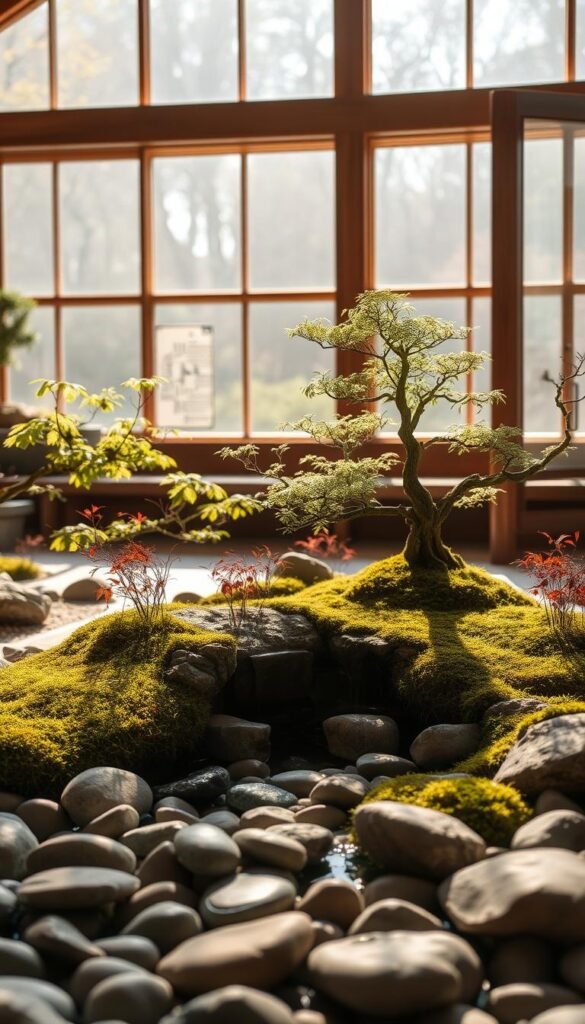Imagine stepping into a room where every detail whispers calm. This is the magic of blending ancient wisdom with today’s living spaces. By focusing on simplicity and nature, you can craft a personal retreat that feels both timeless and fresh.
Natural textures like wood and stone form the backbone of this aesthetic. These materials don’t just look beautiful—they create a tactile connection to the earth. Pair them with clean lines and open space to let each element breathe.
Think about adding sliding screens or low furniture to define areas without clutter. Water features or petite plants bring life indoors while honoring balance. Even in compact homes, clever design choices make serenity possible.
This approach isn’t just about looks—it’s a mindset. Embracing imperfections and purposeful emptiness helps quiet the noise of daily life. Ready to turn your living area into a mindful oasis? Let’s explore how to start.
Embracing the Zen Philosophy in Your Home
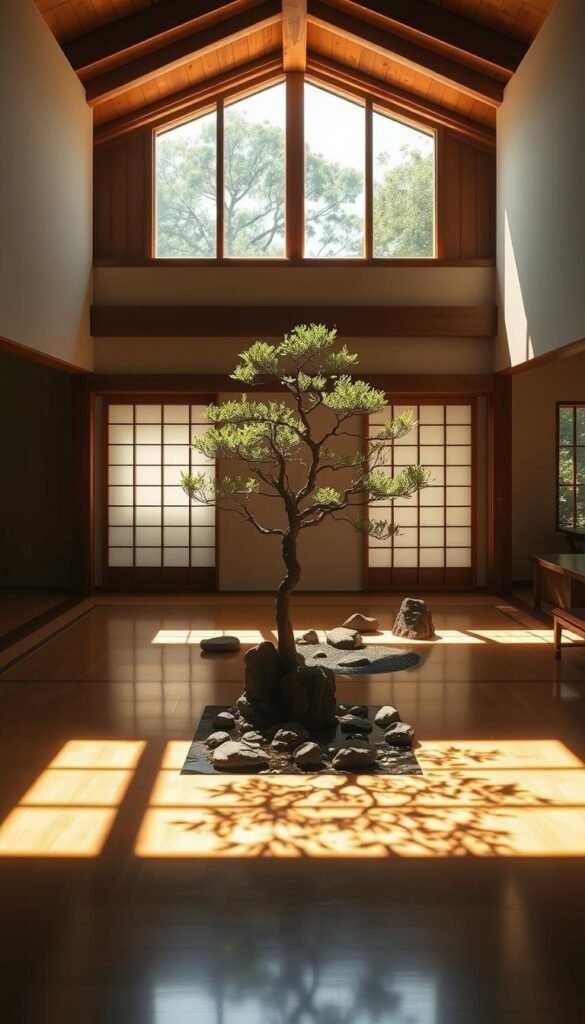
Your home becomes a sanctuary when you let ancient principles guide its rhythm. This approach isn’t about strict rules—it’s about shaping an environment that create sense of stillness. Start by viewing your rooms as evolving canvases where simplicity takes center stage.
The Essence of Minimalism
True minimalism means choosing quality over quantity. Every item in your living space should earn its place—ask yourself if it sparks joy or serves a purpose. The Japanese concept of ma (empty space) teaches that gaps between objects are just as vital as the objects themselves.
Neutral colors like soft grays and warm beiges form a soothing backdrop. They let natural textures—woven baskets, raw wood—shine without competition. This balance helps your design feel intentional, not accidental.
Finding Inner Calm through Design
Clutter isn’t just physical—it’s visual. Replace crowded shelves with a single meaningful decoration. A low table beside a sunlit window becomes a spot for tea, not storage. These choices create sense of order that quiets mental chatter.
Designate a corner for reflection. A floor cushion and slender vase with one branch can transform unused space into a meditation nook. When your surroundings mirror inner peace, you’ll naturally feel a sense calm seep into daily routines.
The Beauty of Natural Materials in Japanese Design
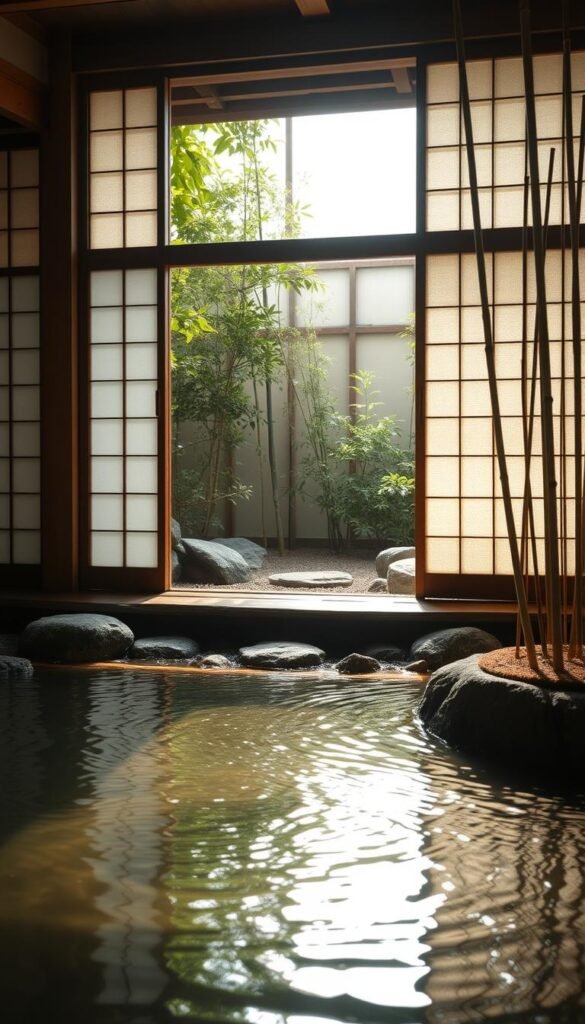
Your fingertips tell the story before your eyes do. Rough-hewn stone, grain-kissed timber, and supple bamboo strands transform rooms into sensory experiences that anchor you to the earth. These elements don’t just decorate—they create space for authenticity.
Wood, Stone, and Bamboo as Key Elements
Think of cedar’s honeyed warmth or hinoki cypress’s crisp aroma. These materials like wood aren’t just surfaces—they’re storytellers. Pair them with river-smoothed stones for contrast, their cool solidity balancing wood’s organic curves.
Bamboo bends the rules. Use it vertically as room dividers that sway gently, or horizontally as floating shelves. Its hollow stems whisper movement into static areas. As architect Tadao Ando once noted: “Materials create sense of place long after designs fade.”
Earthy Tones to Ground Your Space
Walnut’s deep chocolates and ashwood’s pale creams form a quiet dialogue. Layer these hues with slate grays and linen whites for depth without drama. Your walls become canvases where light paints new scenes hourly.
Embrace imperfections—a knotted pine panel, a moss-flecked stone. These flaws celebrate natural materials’ aging process, embodying wabi-sabi’s poetic transience. Your home becomes richer as it weathers life alongside you.
Indoor Japanese Garden: Merging Zen Principles with Modern Interiors
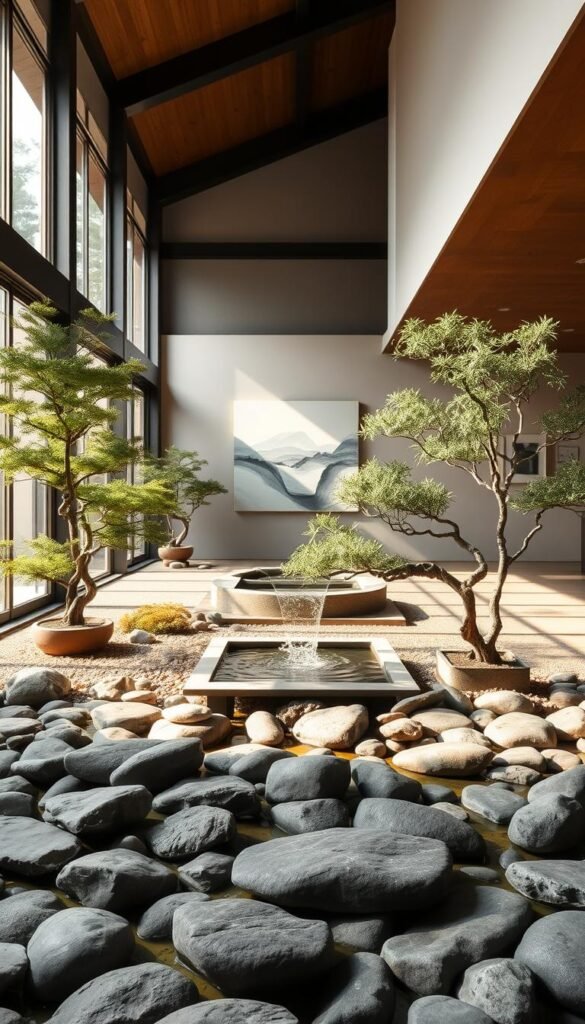
What if your home could balance centuries-old wisdom with today’s sleek aesthetics? Start by reimagining classic zen gardens through a contemporary lens. A bonsai tree becomes living sculpture on a concrete console, while pebble arrangements mimic abstract art beneath glass coffee tables.
Modern interior design thrives on contrast. Pair rough-hewn stone pathways with polished floors—their textures create dialogue between eras. Water features evolve too: slim copper channels replace ponds, carrying trickling streams across kitchen islands or entryways.
Lighting transforms traditional japanese elements. Hide LED strips behind floating shelves to backlight bamboo stalks. As architect Kengo Kuma observes: “Technology lets us whisper nature’s poetry into steel-and-glass rooms.”
Balance matters most. Offset angular furniture with asymmetrical plant groupings. Let one bold element shine—like a black basalt fountain—while keeping other space areas minimalist. This approach honors design principles without feeling like a museum exhibit.
Your rooms become layered stories. A single shōji panel reflects moonlight near smart blinds. Moss grows between patio pavers visible through floor-to-ceiling windows. Every choice bridges then and now, creating zen gardens that feel both ancestral and unmistakably yours.
Incorporating Shoji Screens and Tatami Mats
Light dances differently through paper screens. Shoji screens diffuse sunlight into honeyed glows, turning harsh rays into gentle embraces. Nearby, woven tatami mats bring earthy textures underfoot—nature’s whisper in urban dwellings.
Choosing the Right Shoji Screens for Diffused Light
Not all paper sings the same light song. Traditional washi creates soft patterns like shadow lace, while synthetic options offer stain resistance. Match wooden frames to your design—cedar for warmth, ash for crisp modernity.
These screens diffuse light while dividing spaces gracefully. Architect Shigeru Ban notes: “Translucent barriers teach walls to breathe.” Use them to frame reading nooks or conceal home offices without closing off airiness.
Benefits of Authentic Tatami Mats
Step onto rush grass woven tight as poetry. True tatami mats release subtle grassy scents that change with seasons—summer’s dry hay, winter’s damp earth. Their standard 3:2 ratio helps plan spaces mathematically harmonious.
Modern hybrids mimic the look with foam cores for sofa-friendly softness. Either version transforms cold floors into inviting zones. Rotate mats yearly to prevent uneven wear—a ritual connecting you to centuries of mindful living.
Maximizing Natural Light for a Serene Ambiance
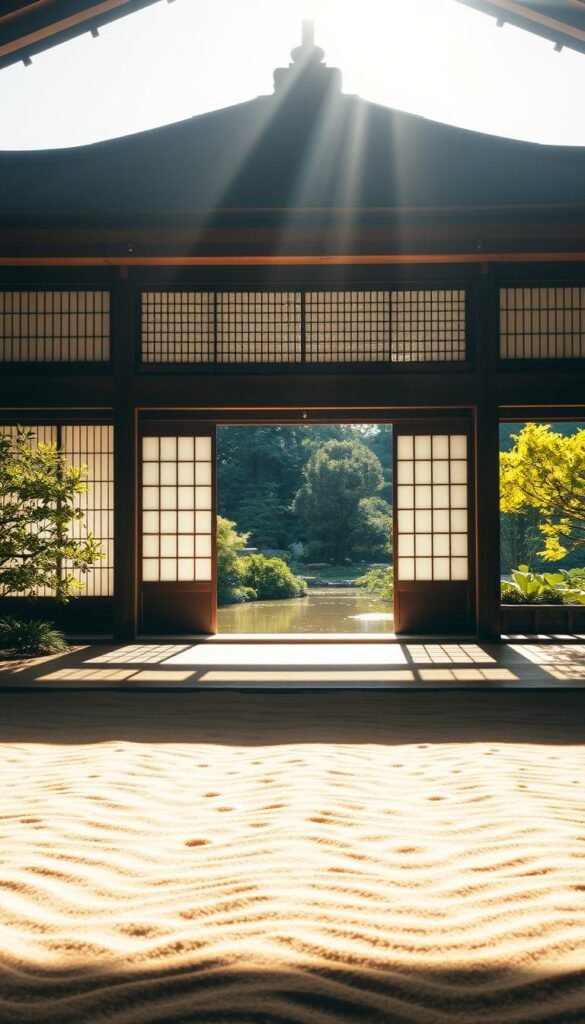
Sunbeams become your best decorator when harnessed thoughtfully. To maximize natural light, start by mapping your room’s brightest spots. Position mirrors opposite windows to amplify light flow, bouncing rays into shadowy corners. Pale walls and glossy floors act as natural reflectors too.
Softening daylight matters as much as quantity. Layer rice-paper shades under sheer curtains—they filter harsh noon sun into gentle glows. Designer Isamu Noguchi once noted: “Light needs texture to become memorable.” Try textured glass partitions that scatter illumination like dappled forest light.
Techniques to Diffuse and Balance Light
Create adaptable zones using these methods:
| Morning | Afternoon | Evening |
|---|---|---|
| Open east-facing screens | Lower bamboo blinds | Use warm LED strips |
| Reflective side tables | Sheer layer over shoji | Dimmable pendant lights |
Rotate furniture seasonally—keep bulky elements away from winter sun paths. Track where glare hits at 3 PM; place plants there to soften hotspots. Your space will feel airy yet intimate, like sunlight filtering through maple leaves.
Balance artificial sources with daylight’s rhythm. Choose bulbs under 2700K for sunset warmth. Hide strip lights above cabinets to wash ceilings with indirect glow. This design approach makes every hour feel intentional, from dawn’s first streak to moonlight’s silver kiss.
Designing a Flexible Open Floor Plan
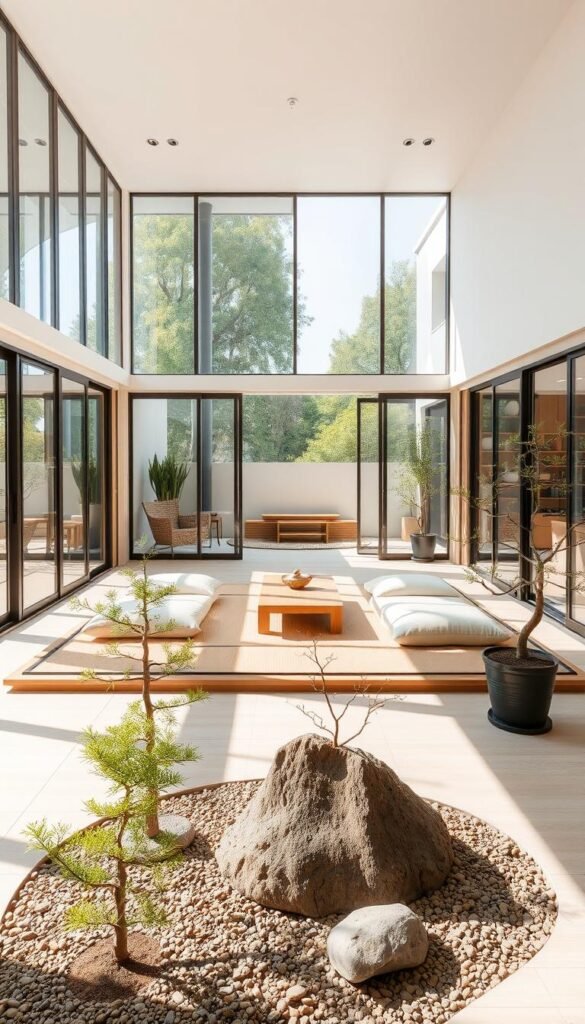
Picture a home that shifts with your daily rhythms. Open layouts thrive on adaptability, letting you keep space flowing yet functional. By replacing walls with visual cues, you craft rooms that whisper “change me” whenever inspiration strikes.
Zoning Techniques for Seamless Transitions
Define areas without boxing them in. Try these approaches:
| Visual Cues | Functional Dividers | Sensory Signals |
|---|---|---|
| Area rugs in contrasting textures | Low bookshelves | Wooden slat screens |
| Pendant lights over tables | Modular seating | Subtle scent diffusers |
Notice how clean lines in furniture maintain sightlines. A console table behind your sofa becomes both divider and display shelf. Designer Ilse Crawford notes: “Good zoning feels discovered, not declared.”
Embracing Minimalist Layouts
Less stuff means more possibilities. Choose multifunctional pieces—a storage ottoman that serves as extra seating, or a dining table that converts to a desk. Keep surfaces clear except for one striking object to keep space feel intentional.
Stick to three main materials throughout your layout. For example: oak floors, linen upholstery, and ceramic accents. This repetition creates harmony while letting each zone shine. Your minimalist design becomes a canvas for life’s changing scenes.
Creating a Dedicated Meditation Corner
Carving out peace in a busy home starts with intentional design. A simple nook with tatami mats and a zafu cushion becomes your daily reset button. This meditation corner thrives on simplicity—no screens, just soft textures and breathing room.
Sliding screens or sheer curtains help create calming boundaries without walls. Position your retreat near natural light sources but away from high-traffic areas. Morning sun through rice paper? Evening shadows dancing on bare walls? Both bring sense of connection to nature’s rhythms.
Essential Elements for Mindfulness
Start with low seating that supports posture. Add dimmable lamps or candles for adjustable ambiance. A tiny sand zen garden or singular stone sculpture gives eyes a resting place during practice.
Keep elements purposeful. Folded blankets in neutral tones invite use without visual noise. Hidden storage under benches tucks away items when not needed. Your space stays clutter-free, letting focus remain inward.
Even apartments can host these sanctuaries. Try floating shelves for incense holders above foldable mats. The key? Consistency. Returning daily to this meditation corner trains your mind to switch gears, turning any room into a gateway for stillness.
